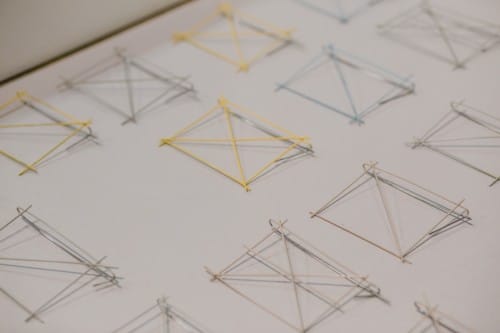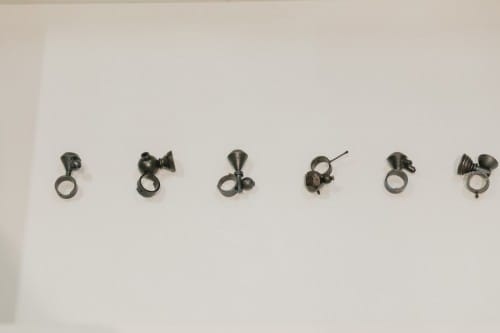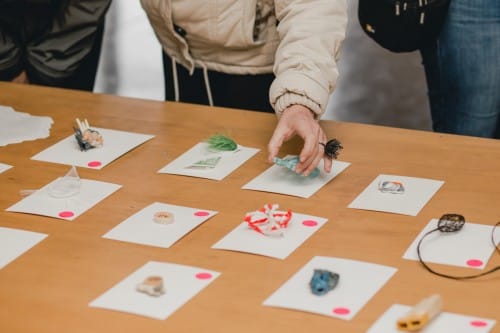Francisca Kweitel (42) studied Fashion Design at the Faculty of Architecture, Design and Urbanism at Buenos Aires University. She then went to Spain, studied at the Civic Center in visual arts, and applied arts and design of the city of Barcelona at the Massana School. She has worked as a jeweler in ‘Metalisteria’ with the industrial designer Marina Molinelli Wells. She has also, along with Guigui Kohon, obtained ownership of the Kweitel-Kohon professorship in the field of 'accessories' in the FADU (Faculty of Architecture, Urban and Design).
'What is a piece of jewel? What are the limits of contemporary jewelry?' Francisca Kweitel asks at the start of the school year to her students in FADU. At the same time, those questions drive her to manage a series of workshops, conferences and exhibitions called 'En Construcción'. Her years of teaching and working in contemporary jewelry determined her ability to carry out the second edition of the symposium 'En Construcción II' in Valparaíso, Chile in 2015.
The birth of 'En Construcción was determined by the actual need for a meeting of researchers, jewelers, artists and other fans of the practice of contemporary jewelry. Its dynamic was organized based on previous symposium structures that happened in other regions of the world. One of those was 'Gray Area'. In April 2010, in Mexico, this meeting on contemporary jewelry was held to foster intercultural dialogue between Latin American and European designers. Over the course of five days, more than fifty artists, designers, academics and researchers gathered in a conducive meeting space for speeches, questions, comments, agreements and disagreements. 'En Construcción' also based itself off of the triennial 'KORU' held in Imatra, Finland. Its purpose is to bring together stakeholders in international contemporary jewelry to participate in workshops, seminars and exhibitions. With these cultural events, and the need for a separate event where the Latin American public could congregate, Francisca Kweitel summoned the Chilean jeweler Pamela de La Fuente and, despite the mountain range separating them, the two were able to carry out the first edition of the symposium 'En Construcción' in Buenos Aires, Argentina in 2012.
In September 2015, the bet was twofold. The second edition of the symposium was organized in the coastal city of Valparaiso, Chile. Argentines, Chileans, Brazilians, Uruguayans, Mexicans and other Latin American nations met in the PCV (Valparaiso Cultural Park). This space used to be a detention center that operated during the Chilean military dictatorship. Today, the former jail is a cultural center that is committed to memory and cultural exchange.
Hands to work.
The symposium took place in three stages. First, the workshops were taught by international guests through dynamic work intended to reflect on the jeweler. Celio Braga is a Brazilian who lives in Amsterdam. In 'La Piel Que Habito' used clothing was utilized as an expressive medium. The purpose sought by the jeweler was work related to the production of body sense, memory, beauty and life marks.
Spanish artist Gemma Draper focused on this exchange in 'Trust me'. In its proposal she invited the participants to reflect on the practice of jewelry in dichotomies ranging from the individual and the collective, the use value and exchange value, and materials and dematerialization of oneself. On the other hand, Portuguese Manuel Vilhena's meeting was theoretical and practical. He referred to the grammar with which to observe one's own and other's productions and works.
Last but not least, the space of Lisa Walker gave the opportunity to practice how to achieve self-expression. Participants having collected material 'obsessively' (as instructed) were challenged to build something that carried their personal stamp. 'Keep going' was her motto.
Each one of the workshops were designed to address hidden concerns about participants’ acquired processes. Issues such as the responsibility to bring new items to the world, and keeping designs sustainable were addressed.
Historical issues resulting from Latin American traditions were also touched upon. Tradition in South America’s jewelry is so strong that it's hard for new experimental works to break through. The workshops also managed to create opportunities for joint working where people could get fresh eyes on their productions.

Gemma Drapper Brooches. PH: Liliana peromarta. Valparaiso, Chile. 2015.
Sharing perspectives.
The second big moment of the event was the conference. Taught by the same artists who delivered the workshops, the conference urged reflection on the process and the sharing of working methods. The artists invited the intimacies of their own processes so that after each take, questioning or reflection on their own creative process occurred. Braga showed how the surrounding world affects him. He appropriates the world brands in their feelings and emotions and turns them into organic objects that refer to the remains of living organs. His pieces beat back the world and transfer his emotions. Lisa Walker toured its production history. Her contribution is a reflection on industrial materials that become part of the everyday, disappear before your eyes, and are revealed by decontextualization. Gemma Draper's conference discussed the idea of belonging to a place. Through images and words the artist reflected on belonging to a territory. She showed pieces and photographic records used to challenge and cross her own personal boundaries. Manuel Vilhena spoke about the cryptic construction of objects and the market. He considered the jewels as condensations of desire that give rise to its value. He was also the only one who referred to the contemporary jewelry market and new exhibition spaces due to the constant variation of the pieces.
The commercialization of pieces of contemporary jewelry in Latin America is an issue. But gradually new exhibition channels that encourage the purchase and sale of these items are being opened. The Thomas Cohn Gallery is one such brave institution opening new market opportunities. The directors of the gallery, Thomas Cohn (1934), and Myriam Tenenbaum Cohn (1939), are a happy risky couple. Art collectors for twenty years now, they opened the gallery in 1983 in Rio, before moving to São Paulo in 1997. In 2012, the partners set out to investigate the international circuit of contemporary jewelry. As a result, the gallery reopened on September 18 at its new address with the show 'COLARES CONTEMPORÁNEAS' which will be followed by regular exhibitions by international artists and lectures for visitors.

Manuel Vilhena's rings. PH: Liliana Peromarta. Valparaiso, Chile. 2015.
Exhibitions around Valparaiso.
The third and final point of the symposium was the most cosmopolitan one. Different schools and jewelry groups from Chile, Argentina, Brazil and Mexico set up different shows located in different parts of the city. The party of forms and materials began in 'Lo Inesperado de lo Cotidiano'. The 'Cerveceria Altamira' hosted Mexican jewelry that reflected on the problems of living in their city. The Broca (Brazil) group 'Re-Trato' was in the 'Galeria Casa E' experiments and reflections materialized on the body and personal feelings through memory. Argentina, meanwhile, exhibited pieces that were clippings of the general population through Muestra, a subset of Argentina's statistical population located on 'Mercado Moderno'. At the Lutheran Church of Valparaiso, 'Rizomas y objetos fluidos' was exhibited. Organized by the School of Jewelry Pamela de la Fuente, organic pieces that questioned the current boundary-free relationship between jewels and users were exhibited. The 'Joy-Eros' group in the 'Galeria Ascensor’ shared pieces exploring human experience through eroticism. The 'Pop-up' of the Kweitel-Kohon students was so captivating that the pieces were sold almost immediately. The FADU design students’ inventiveness was a total success. And finally, in 'Piezas En Construccion' the pieces materialized of the workshop’s participants were shown. Beyond the magnificence of humble pieces paraded all kinds of time limited productions, technical, speeches and elaborate concepts, the warmth of a meeting even took place. The parts required changes in posture to be observed. As changes to each of the participants had to suffer to come from the known, of learning and delivered to changing inner posture. Materials that were exhibited changed processes, exchanges, connections, and provoked meetings and air changes.

Kweitel-Kohon`s Pop-up store. Valparaiso, Chile. 2015
Jewelry in Latin America is certainly a field that benefits from the continual sharing and feedback of these types of encounters. This is not only because this kind of cultural efforts reunites artists with their roots, it also exposes them to new materials, colors, flavors, and forms of collective expression and thus delves into new questions and debates about the limits of contemporary jewelry in South America.
Tags
Argentina / Art / Chile / Contemporary jewelry / En Construccion / Francisca Kweitel / Latin America
Argentina / Art / Chile / Contemporary jewelry / En Construccion / Francisca Kweitel / Latin America
